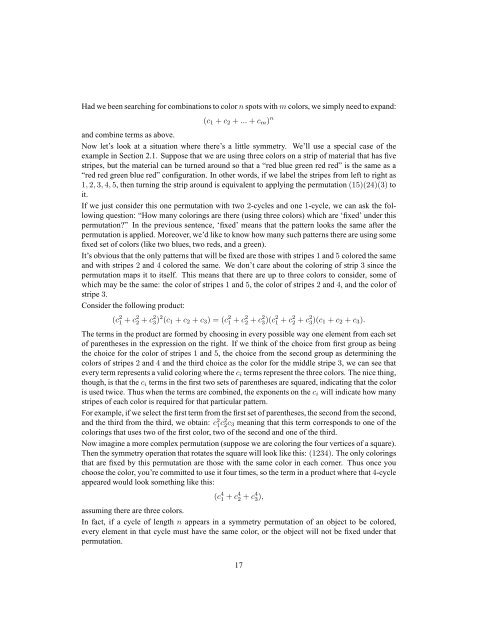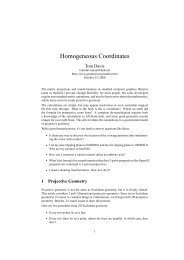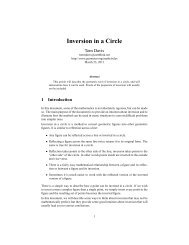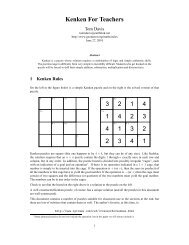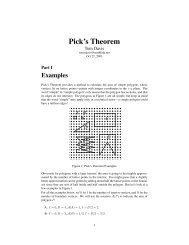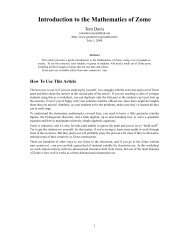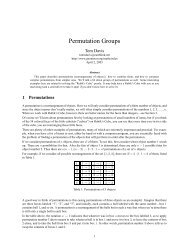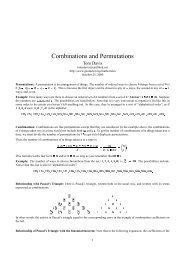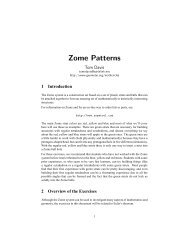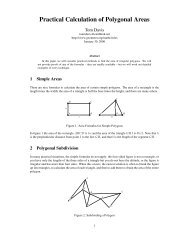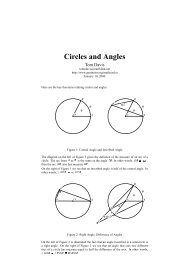P´olya's Counting Theory - Home Page -- Tom Davis
P´olya's Counting Theory - Home Page -- Tom Davis
P´olya's Counting Theory - Home Page -- Tom Davis
Create successful ePaper yourself
Turn your PDF publications into a flip-book with our unique Google optimized e-Paper software.
Had we been searching for combinations to color n spots with m colors, we simply need to expand:<br />
(c 1 + c 2 + ... + c m ) n<br />
and combine terms as above.<br />
Now let’s look at a situation where there’s a little symmetry. We’ll use a special case of the<br />
example in Section 2.1. Suppose that we are using three colors on a strip of material that has five<br />
stripes, but the material can be turned around so that a “red blue green red red” is the same as a<br />
“red red green blue red” configuration. In other words, if we label the stripes from left to right as<br />
1, 2, 3, 4, 5, then turning the strip around is equivalent to applying the permutation (15)(24)(3) to<br />
it.<br />
If we just consider this one permutation with two 2-cycles and one 1-cycle, we can ask the following<br />
question: “How many colorings are there (using three colors) which are ‘fixed’ under this<br />
permutation?” In the previous sentence, ‘fixed’ means that the pattern looks the same after the<br />
permutation is applied. Moreover, we’d like to know how many such patterns there are using some<br />
fixed set of colors (like two blues, two reds, and a green).<br />
It’s obvious that the only patterns that will be fixed are those with stripes 1 and 5 colored the same<br />
and with stripes 2 and 4 colored the same. We don’t care about the coloring of strip 3 since the<br />
permutation maps it to itself. This means that there are up to three colors to consider, some of<br />
which may be the same: the color of stripes 1 and 5, the color of stripes 2 and 4, and the color of<br />
stripe 3.<br />
Consider the following product:<br />
(c 2 1 + c2 2 + c2 3 )2 (c 1 + c 2 + c 3 ) = (c 2 1 + c2 2 + c2 3 )(c2 1 + c2 2 + c2 3 )(c 1 + c 2 + c 3 ).<br />
The terms in the product are formed by choosing in every possible way one element from each set<br />
of parentheses in the expression on the right. If we think of the choice from first group as being<br />
the choice for the color of stripes 1 and 5, the choice from the second group as determining the<br />
colors of stripes 2 and 4 and the third choice as the color for the middle stripe 3, we can see that<br />
every term represents a valid coloring where the c i terms represent the three colors. The nice thing,<br />
though, is that the c i terms in the first two sets of parentheses are squared, indicating that the color<br />
is used twice. Thus when the terms are combined, the exponents on the c i will indicate how many<br />
stripes of each color is required for that particular pattern.<br />
For example, if we select the first term from the first set of parentheses, the second from the second,<br />
and the third from the third, we obtain: c 2 1 c2 2 c 3 meaning that this term corresponds to one of the<br />
colorings that uses two of the first color, two of the second and one of the third.<br />
Now imagine a more complex permutation (suppose we are coloring the four vertices of a square).<br />
Then the symmetry operation that rotates the square will look like this: (1234). The only colorings<br />
that are fixed by this permutation are those with the same color in each corner. Thus once you<br />
choose the color, you’re committed to use it four times, so the term in a product where that 4-cycle<br />
appeared would look something like this:<br />
(c 4 1 + c4 2 + c4 3 ),<br />
assuming there are three colors.<br />
In fact, if a cycle of length n appears in a symmetry permutation of an object to be colored,<br />
every element in that cycle must have the same color, or the object will not be fixed under that<br />
permutation.<br />
17


